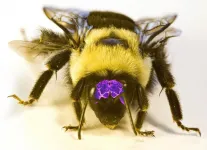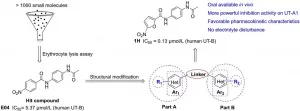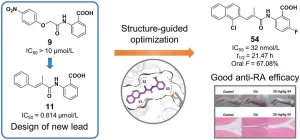Published in the scientific journal Proceedings of the Royal Society B, the study marks the first time the new cell counting method has been applied to invertebrate animals and provides a robust and reproducible protocol for other research groups studying the brains of invertebrate animals.
For more than a century, scientists have attempted to measure and compare the brains and brain components of vertebrates across species in efforts to draw conclusions about how brains support the animals' behavioral and cognitive abilities and ecological requirements. Theories of cognitive capacities of animal brains, including those of fossilized remains of the evolutionary ancestors of humans, are based on such measures.
To that end, scientists need to know how many neurons make up a given brain. Until recently, it was extremely tedious and time-consuming to count or estimate the number of neurons in a brain, even with computer and software-based systems.
For this reason, there were very few reliable neuron numbers available for any animals, including the human brain. Instead, brain researchers relied on estimates and extrapolations based on measurements of brain size or mass. But that approach can be fraught with uncertainties and biases, according to the authors of this study. For example, while larger animals, as a general rule, tend to have larger brains than smaller animals, the volume and mass of a given brain alone don't say much about its cognitive capabilities. "How big or how heavy a brain is does not give you the best measure of an animal's cognitive capabilities," says the study's lead author, R. Keating Godfrey, a postdoctoral researcher in the Department of Molecular and Cellular Biology.
Why 'bird brain' Is actually a compliment
One major reason is that the size of a brain is less relevant for its processing capacities compared with the number of neurons, or nerve cells, it contains. This is analogous to the processing power of a computer, which has little to do with the physical size of its central processor. Neurons are highly specialized types of cells found in virtually any species across the animal kingdom.
Contrast, for example, the sea hare - a giant sea slug found off the coast of California that can weigh more than 12 pounds - with the fruit fly Drosophila. The sea slug's brain alone dwarfs the entire fly by a lot, yet it has just 18,000 neurons, far fewer than the fly's approximately 100,000.
"Just because the brain of one species may be 10 times larger than that of another does not mean it has 10 times as many neurons," says the paper's senior author, Wulfila Gronenberg, a professor of neuroscience who heads a Department of Neuroscience research group dedicated to unraveling the mysteries of insect brains.
Whereas "bird brain" is widely used as a derogatory term for a lack of intelligence, it actually is a misnomer, Gronenberg says.
"Bird brains have many more neurons than a typical mammal of comparable size," he says. "Birds have to navigate a three-dimensional space by flight, and in order to get all that processing power into a small, lightweight package, their neurons are smaller and more densely packed."
Social brains
Gronenberg's research group is interested in the neuronal underpinnings of insects that live in social communities, like honeybees or many wasps.
"We wanted to know: Is there something special about the brains of social insects?" Godfrey says.
Specifically, she and her colleagues set out to study whether the "social brain" hypothesis, which was developed for vertebrate animals and postulates that the size of a brain or particular brain region is correlated with social group size and group behaviors, also holds true for social insects.
With the help of undergraduate students, Godfrey worked on adapting a technique - developed in 2005 by Brazilian neuroscientist Suzanna Herculano-Houzel that revolutionized the field of vertebrate neuroscience - to the insect brains. Instead of slicing brains into hundreds or thousands of thin sections and counting neurons in each section, the method requires only that the brain tissue is homogenized. That's science speak for "blended," which results in a brain soup.
"We release the nuclei from the cells so we can count them," Godfrey says. "Vertebrates have dedicated brain regions and structures that you can sample from, but in insects, we can only really squish the whole thing. So we get a neuron density count for the entire brain."
Godfrey and her co-authors compared the brain cell counts with the body sizes of a large range of hymenoptera - bees, wasps and ants - and found that the neuron number and brain size relationships are very similar to those found in vertebrates.
Putting a number on an ant brain
Certain bees, the team reports, have particularly high numbers of neurons, which should stimulate renewed research into their behavioral capacities, and ants, in general, have fewer neurons than their wasp and bee relatives, probably because they do not fly and thus need less brain power for visual processing and flight control.
Some bees, it turned out, have even higher brain cell densities than some of the most compact bird and mammal brains. For example, the metallic green sweat bee, which is commonly seen in the Southwest and belongs to the genus Augochlorella, has a particularly high number of neurons for its brain size: about 2 million per milligram, more than the highest neuron densities found in the smallest vertebrate species - smoky shrews in mammals and goldcrests in birds.
Ants, on the other hand, tended to come in on the lower end of the spectrum. Compared with bees and wasps, ants had small brains and relatively few brain cells. A desert harvesting ant species common in Arizona amounted to just 400,000 cells per milligram of brain mass. Considering that this ant's brain weighs in at less than 1 milligram, this animal makes do with a total of 90,000 or so brain cells, Gronenberg estimates.
"We think this has to do with the ability to fly, which would make it less about intelligence but more about processing of information," he says. "Ants rely on scent information, whereas bees rely more on visual information."
How low can you go?
These findings beg the question of how many brain cells nature needs to make a functioning brain. Invertebrate brains tend to have highly specialized neurons, each performing a certain task, according to the authors of the study, which allows them to accomplish tasks with a small brain and a small number of neurons.
Gronenberg points to the tiny fairy wasp as a strong contender for the "tiniest brain in the insect world" award. Three strands of human hair, laid side by side, would cover the body length of the tiny creature, whose brain consists of fewer than 10,000 neurons.
"Yet, this parasitic wasp can do all the things it needs to do to survive," Gronenberg says.
"It can find a host, it can mate, it can lay eggs, it can walk and it can fly," he says. "While a small insect may just have one or a few neurons to perform a particular function, humans and other vertebrates tend to have many thousands, or even tens of thousands, of these specialized neurons dedicated to one task, which allows us to do things more precisely and in a more sophisticated way."
INFORMATION:
The research paper was co-authored by Mira Swartzlander, who participated in the work in Gronenberg's lab as part of the KEYS Research Internship Program, a summer research opportunity for high school students offered by the UArizona BIO5 Institute.
This work was supported by the National Science Foundation (grant number ISO-1354191) and a fellowship from the university's Graduate Interdisciplinary Program.






